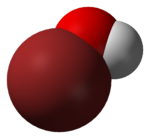Hypobromous acid
 |
|
| Names | |
|---|---|
|
IUPAC name
hypobromous acid, bromic(I) acid
|
|
| Identifiers | |
|
3D model (JSmol)
|
|
| ChEBI | |
| ChemSpider | |
| ECHA InfoCard | 100.119.006 |
|
PubChem CID
|
|
|
|
|
|
| Properties | |
| HBrO | |
| Molar mass | 96.911 |
| Density | 2.470 g/cm |
| Boiling point | 20–25 °C (68–77 °F; 293–298 K) |
| Acidity (pKa) | 8.65 |
|
Except where otherwise noted, data are given for materials in their standard state (at 25 °C [77 °F], 100 kPa).
|
|
|
|
|
| Infobox references | |
Hypobromous acid is a very weak and unstable acid with chemical formula of HOBr. It is also called bromic(I) acid, bromanol or hydroxidobromine. It occurs only in solution and has chemical and physical properties that are very similar to those of other hypohalites. Its salts (hypobromites) are also unstable.
Addition of bromine to water gives hypobromous acid and hydrobromic acid (HBr) via a disproportionation reaction.
Hypobromous acid has a pKa of 8.65 and is therefore only partially dissociated in water at pH 7. Like the acid, hypobromite salts are unstable and undergo a slow disproportionation reaction to yield the respective bromate and bromide salts.
HOBr is used as a bleach, an oxidizer, a deodorant, and a disinfectant, due to its ability to kill the cells of many pathogens. The compound is generated in warm-blooded vertebrate organisms especially by eosinophils, which produce it by the action of eosinophil peroxidase, an enzyme which preferentially uses bromide. Bromide is also used in hot tubs and spas as a germicidal agent, using the action of an oxidizing agent to generate hypobromite in a similar fashion to the peroxidase in eosinophils. It is especially effective when used in combination with its congener, hypochlorous acid.
...
Wikipedia
